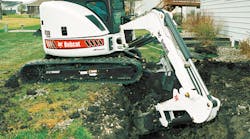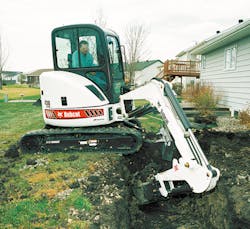Bobcat’s 430 excavator is a true zero house swing (ZHS) unit with the power and operating comfort of a mid-size machine. The excavator features the industry’s first all-hydrostatic drive system and improved maneuvering and traveling performance.
“We have taken the common zero tail swing (ZTS) excavator and significantly improved on it,” explained Tom Connor, Bobcat excavator product representative. With ZTS, the tail of the machine does not extend beyond the width of the undercarriage when slewing the machine, and the house of the machine remains inside the outside edges of the tracks throughout a 360° rotation.
“The 430 provides a greater range of house rotation when working in extremely tight applications,” offered Connor. “As long as the tracks aren’t touching a building, wall, tree or other structure, then the house won’t hit it when you’re working — whether you’re swinging from a trench to a dump truck or digging with the boom offset right or left.”
The drive system
“The 430’s FastTrack drive system works like the drive system on a skid-steer loader,” said Connor. “You can split power infinitely between the left and right tracks.” The end result, he says, is more torque, more precise maneuvering, and smooth acceleration.
In a conventional excavator drive system, oil for the drive function comes from a pump or pump group that also supplies oil to the excavator’s work group functions (boom, bucket, arm, etc.). With the conventional system, the rate of flow to the drive motor is controlled (metered) by a spool. Maximum drive circuit pressure is typically not achieved until the spool is fully stroked and maximum drive torque is only achieved at maximum travel speed. The operator is not necessarily controlling the rate of flow generated, but the amount of flow allowed to the drive motor. Moving the travel levers/pedals, causes a spool to shift in the hydraulic valve, allowing flow to go to the drive motor circuit. Depending on the system, the spool is activated either by direct mechanical linkage or via pilot pressure.
Dedicated circuits
With the FastTrack system, each of the excavator’s two drive motors is supplied by a separate variable displacement pump. One pump is dedicated to the left drive function, and another to the right drive function. Flow from these pumps is used only for its assigned drivemotor, and not for any of the excavator’s other functions. One advantage of this system is that it gives optimum multi-functionality because the operator can move the boom, the arm, or any of the excavator’s work group functions without affecting the travel circuits.
Additionally, with the hydrostatic FastTrack system, rate of flow to a drive motor is determined by input from the operator via a pilot pressure control system. As the operator moves a travel lever/pedal, the control mechanism sends a hydraulic signal for the pump to create flow. Flow is not generated until the operator calls for it. The system, like that used in a skid steer, allows for greater torque at lower speeds and improved torque control throughout the full range of travel speed. This allows for smoother turns and greater ability to maneuver the excavator while using the blade to level material.
The 430 uses separate piston pumps and high torque drive motors to power the left and right tracks. Connor said it’s the first and only excavator to offer this feature — a true hydrostatic drive that replaces the conventional hydraulic system found on other excavators.
“It’s a great machine for backfilling trenches or doing final landscape grading,” continued Connor. “Also, it allows you to make gradual, smooth turns on surfaces like asphalt or concrete. This machine drives like a skid-steer loader, and nearly as fast.”
Dual blade cylinders
Instead of a single center-mounted cylinder, a cylinder on each side of the 70-in. blade reduces the amount of dirt and debris that can build up on top of the blade structure. The advantage of dual blade cylinders is that this arrangement creates a wide, open space between the blade’s arm structure. The cylinders are placed directly above the two “arms” of the blade, thus creating an open space in the middle. This allows debris to fall through much easier.
With a single, center mounted blade cylinder, the location of the cylinder has a tendency to restrict material from falling through this area. Connor explained, “It’s like holding three fingers out and dumping dirt on top of them. If you were to retract the center finger, material will pass through much easier.”
The dual blade arrangement also provides protection for the bottom side of the blade cylinders. If the operator were to lower the blade down in rocky conditions, the blade’s “arm” structure will contact the rocks, thus protecting the bottom side of the blade cylinder from damage.
Other improvements
Hydraulic hoses are routed within the width of the arm of the 430 to improve protection from snagging and other damage. This means more reliable operation and more productive up-time.
The 430 excavator is powered by a Kubota 43-hp direct injection, liquid-cooled engine. Compared to the indirect injection engines found on most other compact excavators, this engine is more fuel efficient, starts better in cold weather, and runs cooler, Connor reported.
By using a hydraulically driven cooling fan instead of a belt driven unit, Bobcat engineers have been able to install the radiator cooling assembly on the side of the machine, where it can draw in air that is cool and clean. A thermostatically controlled fan matches air flow to the cooling requirements, which reduces noise and improves fuel efficiency.


